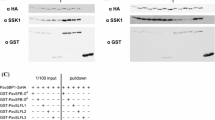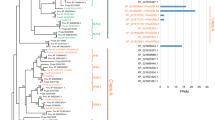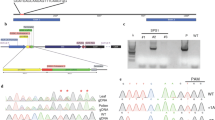Abstract
S-RNase-based self-incompatibility (SI) is an intraspecific reproductive barrier to prevent self-fertilization found in many species of the Solanaceae, Plantaginaceae and Rosaceae. In this system, S-RNase and SLF/SFB (S-locus F-box) genes have been shown to control the pistil and pollen SI specificity, respectively. Recent studies have shown that the SLF functions as a substrate receptor of a SCF (Skp1/Cullin1/F-box)-type E3 ubiquitin ligase complex to target S-RNases in Solanaceae and Plantaginaceae, but its role in Rosaceae remains largely undefined. Here we report the identification of two pollen-specific SLF-interacting Skp1-like (SSK) proteins, PbSSK1 and PbSSK2, in Pyrus bretschneideri from the tribe Pyreae of Rosaceae. Both yeast two-hybrid and pull-down assays demonstrated that they could connect PbSLFs to PbCUL1 to form a putative canonical SCFSLF (SSK/CUL1/SLF) complex in Pyrus. Furthermore, pull-down assays showed that the SSK proteins could bind SLF and CUL1 in a cross-species manner between Pyrus and Petunia. Additionally, phylogenetic analysis revealed that the SSK-like proteins from Solanaceae, Plantaginaceae and Rosaceae form a monoclade group, hinting their shared evolutionary origin. Taken together, with the recent identification of a canonical SCFSFB complex in Prunus of the tribe Amygdaleae of Rosaceae, our results show that a conserved canonical SCFSLF/SFB complex is present in Solanaceae, Plantaginaceae and Rosaceae, implying that S-RNase-based self-incompatibility shares a similar molecular and biochemical mechanism.






Similar content being viewed by others
Abbreviations
- SI:
-
Self-incompatibility
- SLF:
-
S-locus F-box
- SFB:
-
S-haplotype-specific F-box
- SFBB:
-
S-locus F-box brother
- SSK:
-
SLF-interacting Skp1-like
- SCF:
-
Skp1-Cullin1-F-box
- SBP1:
-
S-RNase-binding protein1
References
Adachi Y, Komori S, Hoshikawa Y, Tanaka N, Abe K, Bessho H, Watanabe M, Suzuki A (2009) Characteristics of fruiting and pollen tube growth of apple autotetraploid cultivars showing self-compatibility. J Japan Soc Hort Sci 78:402–409
Anderson MA, Cornish EC, Mau S-L, Williams EG, Hoggart R, Atkinson A, Bonig I, Grego B, Simpson R, Roche PJ, Haley JD, Penschow JD, Niall HD, Tregear GW, Coghlan JP, Crawford RJ, Clarke AE (1986) Cloning of cDNA for a stylar glycoprotein associated with expression of self-incompatibility in Nicotiana alata. Nature 321:38–44
Chang LC, Guo CL, Lin YS, Fu H, Wang CS, Jauh GY (2009) Pollen-specific SKP1-like proteins are components of functional scf complexes and essential for lily pollen tube elongation. Plant Cell Physiol 50:1558–1572
Chen G, Zhang B, Zhao Z, Sui Z, Zhang H, Xue Y (2010) ‘A life or death decision’ for pollen tubes in S-RNase-based self-incompatibility. J Exp Bot 61:2027–2037
Chen G, Zhang B, Liu L, Li Q, Zhang Y, Xie Q, Xue Y (2012) Identification of a ubiquitin-binding structure in the S-locus F-box protein controlling S-RNase-based self-incompatibility. J Genet Genom 39:93–102
Chenna R, Sugawara H, Koike T, Lopez R, Gibson TJ, Higgins DG, Thompson JD (2003) Multiple sequence alignment with the Clustal series of programs. Nucleic Acids Res 31:3497–3500
Crane M, Lewis D (1942) Genetical studies in pears III. Incompatibility and sterility. J Genet 43:31–43
De Nettancourt D (2001) Incompatibility and incongruity in wild and cultivated plants, 2nd edn. Springer, Heidelberg
Entani T, Takayama S, Iwano M, Shiba H, Che FS, Isogai A (1999) Relationship between polyploidy and pollen self-incompatibility phenotype in Petunia hybrida Vilm. Biosci Biotechnol Biochem 63:1882–1888
Entani T, Iwano M, Shiba H, Che FS, Isogai A, Takayama S (2003) Comparative analysis of the self-incompatibility (S-) locus region of Prunus mume: identification of a pollen-expressed F-box gene with allelic diversity. Genes Cells 8:203–213
Franklin-Tong VE (2008) Self-incompatibility in flowering plants. Springer, Heidelberg
Gagne JM, Downes BP, Shiu SH, Durski AM, Vierstra RD (2002) The F-box subunit of the SCF E3 complex is encoded by a diverse superfamily of genes in Arabidopsis. Proc Natl Acad Sci USA 99:11519–11524
Goldraij A, Kondo K, Lee CB, Hancock CN, Sivaguru M, Vazquez-Santana S, Kim S, Phillips TE, Cruz-Garcia F, McClure B (2006) Compartmentalization of S-RNase and HT-B degradation in self-incompatible Nicotiana. Nature 439:805–810
Golz JF, Su V, Clarke AE, Newbigin E (1999) A molecular description of mutations affecting the pollen component of the Nicotiana alata S locus. Genetics 152:1123–1135
Golz JF, Oh HY, Su V, Kusaba M, Newbigin E (2001) Genetic analysis of Nicotiana pollen-part mutants is consistent with the presence of an S-ribonuclease inhibitor at the S locus. Proc Natl Acad Sci USA 98:15372–15376
Hauck NR, Ikeda K, Tao R, Iezzoni AF (2006a) The mutated S 1 -haplotype in sour cherry has an altered S-haplotype-specific F-box protein gene. J Hered 97:514–520
Hauck NR, Yamane H, Tao R, Iezzoni AF (2006b) Accumulation of nonfunctional S-haplotypes results in the breakdown of gametophytic self-incompatibility in tetraploid Prunus. Genetics 172:1191–1198
Hua Z, Kao TH (2006) Identification and characterization of components of a putative Petunia S-locus F-box-containing E3 ligase complex involved in S-RNase-based self-incompatibility. Plant Cell 18:2531–2553
Hua Z, Kao TH (2008) Identification of major lysine residues of S(3)-RNase of Petunia inflata involved in ubiquitin-26S proteasome-mediated degradation in vitro. Plant J 54:1094–1104
Hua Z, Meng X, Kao TH (2007) Comparison of Petunia inflata S-Locus F-box protein (Pi SLF) with Pi SLF like proteins reveals its unique function in S-RNase based self-incompatibility. Plant Cell 19:3593–3609
Huang J, Zhao L, Yang Q, Xue Y (2006) AhSSK1, a novel SKP1-like protein that interacts with the S-locus F-box protein SLF. Plant J 46:780–793
Igic B, Kohn JR (2001) Evolutionary relationships among self-incompatibility RNases. Proc Natl Acad Sci USA 98:13167–13171
Kakui H, Kato M, Ushijima K, Kitaguchi M, Kato S, Sassa H (2011) Sequence divergence and loss-of-function phenotypes of S locus F-box brothers genes are consistent with non-self recognition by multiple pollen determinants in self-incompatibility of Japanese pear (Pyrus pyrifolia). Plant J 68:1028–1038
Kong H, Landherr LL, Frohlich MW, Leebens-Mack J, Ma H, dePamphilis CW (2007) Patterns of gene duplication in the plant SKP1 gene family in angiosperms: evidence for multiple mechanisms of rapid gene birth. Plant J 50:873–885
Kubo K, Entani T, Takara A, Wang N, Fields AM, Hua Z, Toyoda M, Kawashima S, Ando T, Isogai A, Kao TH, Takayama S (2010) Collaborative non-self recognition system in S-RNase-based self-incompatibility. Science 330:796–799
Lai Z, Ma W, Han B, Liang L, Zhang Y, Hong G, Xue Y (2002) An F-box gene linked to the self-incompatibility (S) locus of Antirrhinum is expressed specifically in pollen and tapetum. Plant Mol Biol 50:29–42
Li MF, Li XF, Han ZH, Shu HR, Li T (2009) Molecular analysis of two Chinese pear (Pyrus bretschneideri Rehd.) spontaneous self-compatible mutants, Yan Zhuang and Jin Zhui. Plant Biol (Stuttg) 11:774–783
Marin I (2009) Diversification of the cullin family. BMC Evol Biol 9:267
Matsumoto D, Yamane H, Abe K, Tao R (2012) Identification of a Skp1-like protein interacting with SFB, the pollen S determinant of the gametophytic self-incompatibility in Prunus. Plant Physiol 159:1252–1262
McClure B, Cruz-Garcia F, Romero C (2011) Compatibility and incompatibility in S-RNase-based systems. Ann Bot 108:647–658
Meng X, Sun P, Kao TH (2011) S-RNase-based self-incompatibility in Petunia inflata. Ann Bot 108:637–646
Minamikawa M, Kakui H, Wang S, Kotoda N, Kikuchi S, Koba T, Sassa H (2010) Apple S locus region represents a large cluster of related, polymorphic and pollen-specific F-box genes. Plant Mol Biol 74:143–154
Neff MM, Neff JD, Chory J, Pepper AE (1998) dCAPS, a simple technique for the genetic analysis of single nucleotide polymorphisms experimental applications in Arabidopsis thaliana genetics. Plant J 14:387–392
Okada K, Tonaka N, Taguchi T, Ichikawa T, Sawamura Y, Nakanishi T, Takasaki-Yasuda T (2011) Related polymorphic F-box protein genes between haplotypes clustering in the BAC contig sequences around the S-RNase of Japanese pear. J Exp Bot 62:1887–1902
Qiao H, Wang F, Zhao L, Zhou J, Lai Z, Zhang Y, Robbins TP, Xue Y (2004a) The F-box protein AhSLF-S2 controls the pollen function of S-RNase-based self-incompatibility. Plant Cell 16:2307–2322
Qiao H, Wang H, Zhao L, Zhou J, Huang J, Zhang Y, Xue Y (2004b) The F-box protein AhSLF-S2 physically interacts with S-RNases that may be inhibited by the ubiquitin/26S proteasome pathway of protein degradation during compatible pollination in Antirrhinum. Plant Cell 16:582–595
Risseeuw EP, Daskalchuk TE, Banks TW, Liu E, Cotelesage J, Hellmann H, Estelle M, Somers DE, Crosby WL (2003) Protein interaction analysis of SCF ubiquitin E3 ligase subunits from Arabidopsis. Plant J 34:753–767
Sassa H, Hirano H, Ikehashi H (1992) Self-incompatibility-related RNases in styles of Japanese pear (Pyrus serotina Rehd.). Plant Cell Physiol 33:811–814
Sassa H, Kakui H, Miyamoto M, Suzuki Y, Hanada T, Ushijima K, Kusaba M, Hirano H, Koba T (2007) S locus F-box brothers: multiple and pollen-specific F-box genes with S haplotype-specific polymorphisms in apple and Japanese pear. Genetics 175:1869–1881
Schulman BA, Carrano AC, Jeffrey PD, Bowen Z, Kinnucan ER, Finnin MS, Elledge SJ, Harper JW, Pagano M, Pavletich NP (2000) Insights into SCF ubiquitin ligases from the structure of the Skp1-Skp2 complex. Nature 408:381–386
Sijacic P, Wang X, Skirpan AL, Wang Y, Dowd PE, McCubbin AG, Huang S, Kao TH (2004) Identification of the pollen determinant of S-RNase-mediated self-incompatibility. Nature 429:302–305
Sims TL, Ordanic M (2001) Identification of a S-ribonuclease-binding protein in Petunia hybrida. Plant Mol Biol 47:771–783
Sonneveld T, Tobutt KR, Vaughan SP, Robbins TP (2005) Loss of pollen-S function in two self-compatible selections of Prunus avium is associated with deletion/mutation of an S haplotype-specific F-box gene. Plant Cell 17:37–51
Steinbachs JE, Holsinger KE (2002) S-RNase-mediated gametophytic self-incompatibility is ancestral in eudicots. Mol Biol Evol 19:825–829
Takayama S, Isogai A (2005) Self-incompatibility in plants. Annu Rev Plant Biol 56:467–489
Tamura K, Peterson D, Peterson N, Stecher G, Nei M, Kumar S (2011) MEGA5: molecular evolutionary genetics analysis using maximum likelihood, evolutionary distance, and maximum parsimony methods. Mol Biol Evol 28:2731–2739
Tsukamoto T, Hauck NR, Tao R, Jiang N, Iezzoni AF (2006) Molecular characterization of three non-functional S-haplotypes in sour cherry (Prunus cerasus). Plant Mol Biol 62:371–383
Ushijima K, Sassa H, Tao R, Yamane H, Dandekar AM, Gradziel TM, Hirano H (1998) Cloning and characterization of cDNAs encoding S-RNases from almond (Prunus dulcis): primary structural features and sequence diversity of the S-RNases in Rosaceae. Mol Gen Genet 260:261–268
Ushijima K, Sassa H, Dandekar AM, Gradziel TM, Tao R, Hirano H (2003) Structural and transcriptional analysis of the self-incompatibility locus of almond: identification of a pollen-expressed F-box gene with haplotype-specific polymorphism. Plant Cell 15:771–781
Ushijima K, Yamane H, Watari A, Kakehi E, Ikeda K, Hauck NR, Iezzoni AF, Tao R (2004) The S haplotype-specific F-box protein gene, SFB, is defective in self-compatible haplotypes of Prunus avium and P. mume. Plant J. 39:573–586
Vilanova S, Badenes ML, Burgos L, Martinez-Calvo J, Llacer G, Romero C (2006) Self-compatibility of two apricot selections is associated with two pollen-part mutations of different nature. Plant Physiol 142:629–641
Wu H, Zhang S, Wu J, Wang Y, Wu J (2007) Mutational mechanism of self-compatible pear cultivar Jinzhuili (Pyrus bretschneideri). Acta Horticulturae Sinica 34 (2):295–300 (in Chinese)
Xue Y, Carpenter R, Dickinson HG, Coen ES (1996) Origin of allelic diversity in Antirrhinum S locus RNases. Plant Cell 8:805–814
Xue Y, Zhang Y, Yang Q, Li Q, Cheng Z, Dickinson HG (2009) Genetic features of a pollen-part mutation suggest an inhibitory role for the Antirrhinum pollen self-incompatibility determinant. Plant Mol Biol 70:499–509
Yamane H, Ikeda K, Ushijima K, Sassa H, Tao R (2003) A pollen-expressed gene for a novel protein with an F-box motif that is very tightly linked to a gene for S-RNase in two species of cherry, Prunus cerasus and P. avium. Plant Cell Physiol 44:764–769
Zhang Y, Zhao Z, Xue Y (2009) Roles of proteolysis in plant self-incompatibility. Annu Rev Plant Biol 60:21–42
Zhao L, Huang J, Zhao Z, Li Q, Sims TL, Xue Y (2010) The Skp1-like protein SSK1 is required for cross-pollen compatibility in S-RNase-based self-incompatibility. Plant J 62:52–63
Zheng N, Schulman BA, Song L, Miller JJ, Jeffrey PD, Wang P, Chu C, Koepp DM, Elledge SJ, Pagano M, Conaway RC, Conaway JW, Harper JW, Pavletich NP (2002) Structure of the Cul1-Rbx1-Skp1-F boxSkp2 SCF ubiquitin ligase complex. Nature 416:703–709
Zhou J, Wang F, Ma W, Zhang Y, Han B, Xue Y (2003) Structural and transcriptional analysis of S-locus F-box genes in Antirrhinum. Sex Plant Reprod 16:165–177
Acknowledgments
We gratefully thank Hui Zhang, Wei Liu and other lab members for their critical comments on the manuscript. This work was supported by National Basic Research Program of China (2011CB915404 and 2013CB945100), National Natural Science Foundation of China (30921003 and 31071784), Beijing Natural Science Foundation (6102017) and Post-doctoral Science Foundation of China (20100480521).
Author information
Authors and Affiliations
Corresponding authors
Additional information
Chi Xu and Maofu Li contributed equally to this work.
Accession numbers: HE802069 (PbSLF3-S 34 ), HE802070 (PbSLF6-S 21 ), HE802072 (PbSSK1), HE802071 (PbSSK2), and HE802075 (PbCUL1).
Electronic supplementary material
Below is the link to the electronic supplementary material.
Rights and permissions
About this article
Cite this article
Xu, C., Li, M., Wu, J. et al. Identification of a canonical SCFSLF complex involved in S-RNase-based self-incompatibility of Pyrus (Rosaceae). Plant Mol Biol 81, 245–257 (2013). https://doi.org/10.1007/s11103-012-9995-x
Received:
Accepted:
Published:
Issue Date:
DOI: https://doi.org/10.1007/s11103-012-9995-x




